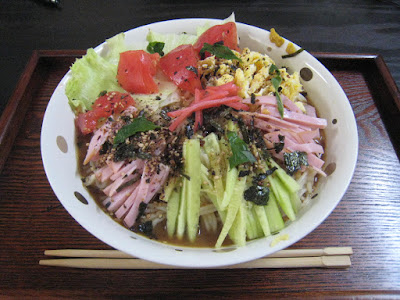Reimen / Hiyashi Chuka
Chilled ramen noodles
冷麺 / 冷やし中華
Reimen is one of my favorite summer dishes – how hot it may be, or how low my appetite, this delicacy always works its wonder! It always helps to revive me thanks to the sourness of the vinegar in the sauce and the lightness of the thin noodles and the vegetables.
[Reimen]
Reimen are boiled, cold noodles served in a sauce of soy sauce and vinegar, and lavishly topped with thinly sliced strips of omelet, ham, cucumber, tomatoes, ginger and sometimes also chicken and pork. The toppings are arranged in a colorful pattern on top of the noodles, the customer has to mix the dish, bringing it up to taste with some mustard.
In fact, the name I use, Reimen, is typical for Western Japan (where I live) – in other parts of Japan this summer dish is called Hiyashi Chuka (“Cold Chinese”), and in Hokkaido the designation Hiyashi Ramen (“Cold Ramen”) is used. Note that this Japanese summer dish is different from the Korean Naengmyeon, which is also pronounced “reimen” in Japanese.
This cold summer dish of Chinese noodles did not come from China, but was invented by a Chinese restaurant in Japan. That was the Chinese restaurant Ryutei in Sendai, and the year was 1937. As other Chinese restaurants, Ryutei always saw its sales dip in the hot Japanese summer, when the Japanese prefer cooler dishes than piping hot ramen noodles. That was all the more regrettable as the annual Tanabata festival brought many tourists to Sendai. So taking a hint from the Ur-Japanese zarusoba dish (cold soba noodles with a soy sauce based dipping), the owner of Ryutei devised a new style of cold Chinese noodles. Interestingly, the cold sauce containing vinegar was not orthodox from a Chinese point of view, as in Chinese cuisine cold dishes with a sour taste are not popular. It was also new for Japan. But reimen soon conquered Japan!
The restaurant in Sendai used different vegetables from today, and therefore other restaurants also lay claim to the crown of being the first, such as Yoshikosaikan, a Chinese restaurant in Jinbocho, Tokyo, where just after the war the vegetables were heaped on the noodles in the form of a small Mt Fuji as still happens today, or Chuka no Sakai in Kyoto which started serving cold noodles with goma (sesame)-sauce in 1939.
Now reimen is so popular that it is served by all Chinese restaurants in Japan, from late spring to early autumn – they always announce the start of the reimen season with banners, flags and posters. Reimen also is a bestseller among supermarket lunches.
Japanese Food Dictionary
